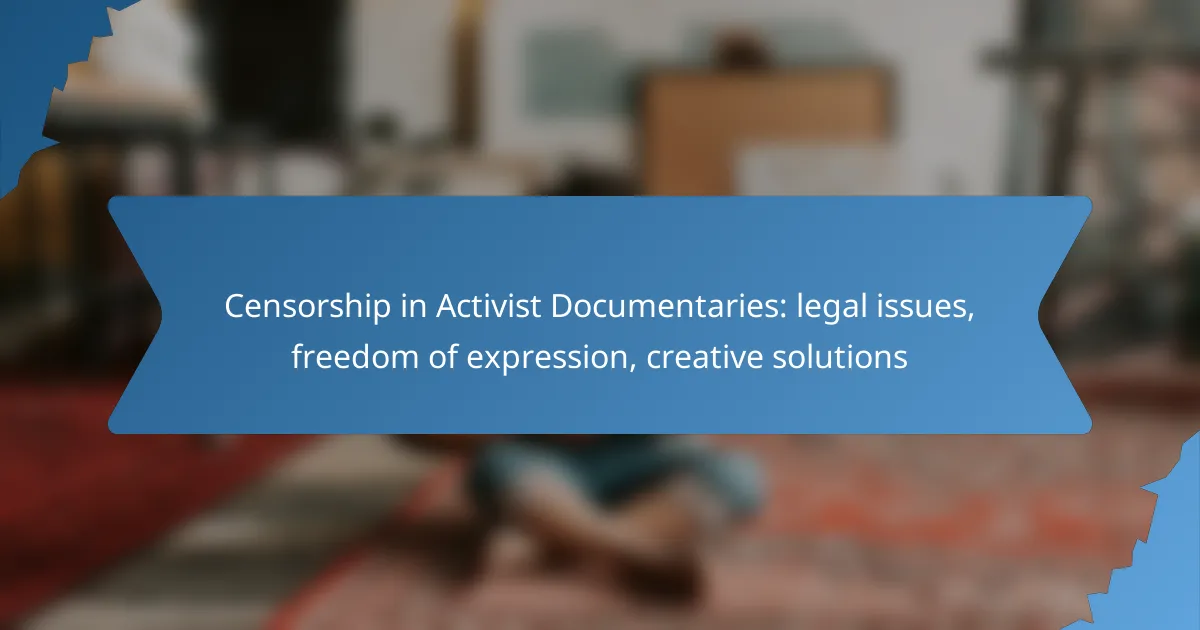Censorship poses significant challenges for activist documentaries, particularly in the UK, where legal issues such as defamation and copyright infringement can hinder filmmakers’ ability to express critical viewpoints. This restriction on freedom of expression not only limits diverse narratives but also undermines the potential for social change. However, filmmakers can explore creative solutions, such as crowdfunding and partnerships with NGOs, to navigate these obstacles and amplify their voices.

What are the legal issues surrounding censorship in activist documentaries in the UK?
Censorship in activist documentaries in the UK involves various legal challenges, primarily related to defamation, copyright infringement, and the public interest defense. Understanding these issues is crucial for filmmakers to navigate the legal landscape while expressing their viewpoints.
Defamation laws
Defamation laws in the UK protect individuals and organizations from false statements that could harm their reputation. Activist documentaries must be careful to avoid making unsubstantiated claims about people or entities, as this could lead to legal action. Filmmakers should verify facts and consider obtaining legal advice before including potentially damaging content.
To mitigate risks, it’s advisable to include disclaimers and ensure that any criticisms are backed by evidence. This approach not only strengthens the documentary’s credibility but also provides a layer of protection against defamation claims.
Copyright infringement
Copyright infringement occurs when a documentary uses protected material without permission from the rights holder. This can include music, footage, or images that are not owned by the filmmaker. In the UK, using copyrighted material without a license can lead to significant legal consequences, including financial penalties.
Filmmakers should seek licenses for any third-party content they wish to use or explore fair use provisions where applicable. Additionally, creating original content or using public domain materials can help avoid copyright issues altogether.
Public interest defense
The public interest defense allows filmmakers to justify the inclusion of certain content that may otherwise be legally questionable. In the UK, this defense can be critical for activist documentaries that aim to highlight social issues or injustices. However, this defense is not absolute and must be carefully considered in the context of the documentary’s goals.
To effectively use the public interest defense, filmmakers should demonstrate that their work contributes to public discourse or awareness. Documenting factual evidence and presenting a balanced viewpoint can strengthen the case for this defense, making it a valuable tool in navigating censorship challenges.
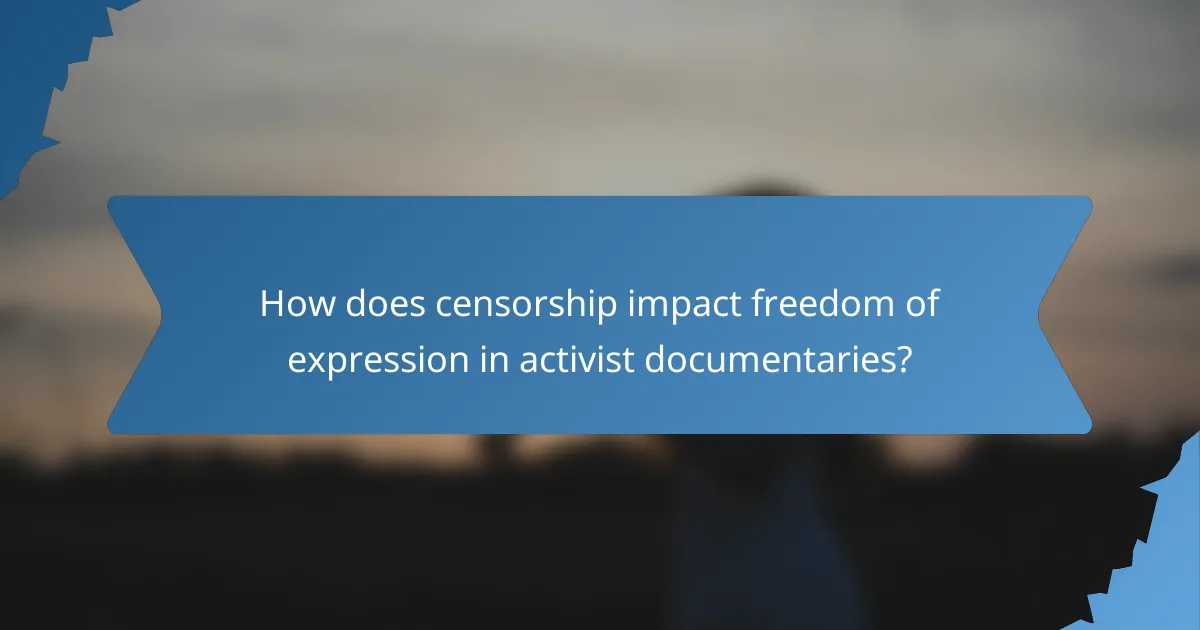
How does censorship impact freedom of expression in activist documentaries?
Censorship significantly restricts freedom of expression in activist documentaries by limiting the ability of filmmakers to convey critical messages and perspectives. This suppression can lead to a homogenization of viewpoints, undermining the diversity of narratives that are essential for social change.
Chilling effect on filmmakers
The chilling effect refers to the discouragement of filmmakers from pursuing certain topics due to fear of censorship or legal repercussions. This can result in a reluctance to tackle controversial issues, which are often central to activist documentaries. For instance, filmmakers may avoid subjects related to government policies or social injustices to sidestep potential backlash.
As a consequence, the range of stories told may narrow, leading to a less informed public. Filmmakers might also resort to indirect storytelling methods, which can dilute the intended message and impact of their work.
Self-censorship among creators
Self-censorship occurs when creators voluntarily limit their content to avoid conflict with authorities or potential backlash from audiences. This practice can stem from past experiences of censorship or a perceived need to conform to societal norms. For example, a filmmaker might choose to omit certain footage or alter narratives to make their work more palatable.
Such self-censorship can stifle creativity and innovation, as filmmakers may hesitate to explore bold or unconventional ideas. To counter this, creators should seek supportive networks and legal advice to understand their rights and navigate potential risks more effectively.
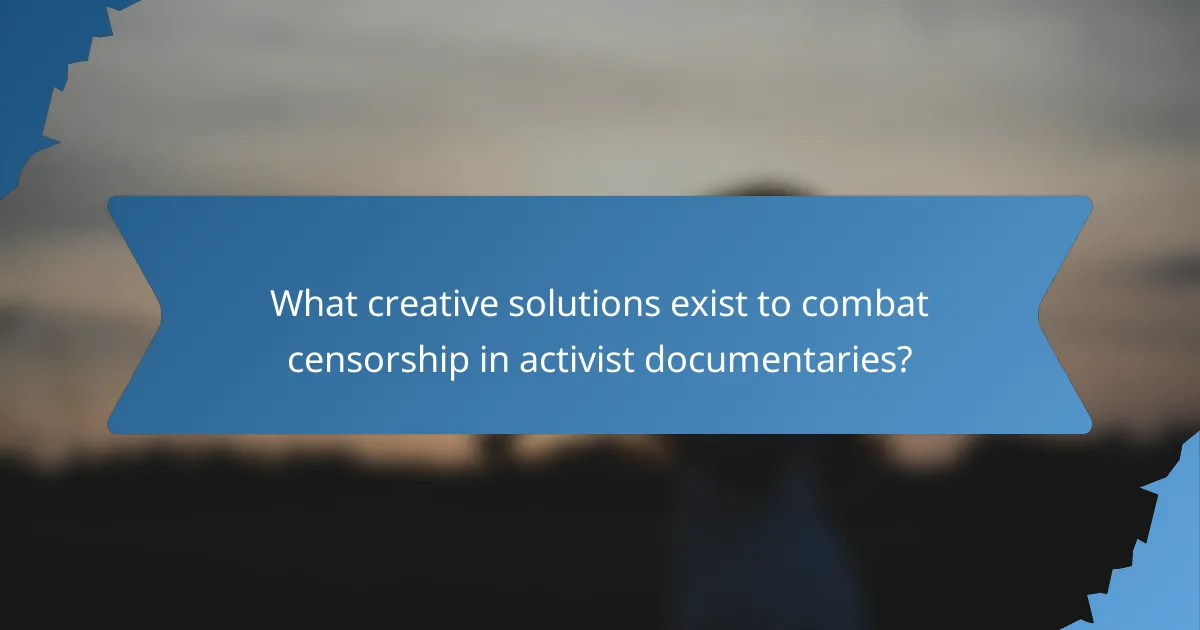
What creative solutions exist to combat censorship in activist documentaries?
Activist documentaries often face censorship, but various creative solutions can help filmmakers navigate these challenges. By leveraging crowdfunding, digital platforms, and partnerships with NGOs, creators can maintain their freedom of expression and reach wider audiences.
Crowdfunding for independent projects
Crowdfunding has become a vital tool for independent filmmakers seeking to finance their projects without relying on traditional funding sources that may impose restrictions. Platforms like Kickstarter and Indiegogo allow creators to connect directly with supporters who value their message, often raising thousands of dollars.
Filmmakers should clearly articulate their vision and the importance of their work to attract backers. Offering rewards, such as exclusive screenings or behind-the-scenes content, can incentivize contributions and foster a sense of community among supporters.
Utilizing digital platforms
Digital platforms provide an alternative distribution method that bypasses traditional media gatekeepers. Services like YouTube, Vimeo, and streaming platforms allow filmmakers to share their work widely without facing immediate censorship from broadcasters or distributors.
To maximize reach, filmmakers should optimize their content for search engines and social media sharing. Engaging with audiences through comments and discussions can also build a loyal following, which can be crucial for future projects.
Collaborations with NGOs
Partnering with non-governmental organizations (NGOs) can enhance the impact and visibility of activist documentaries. NGOs often have established networks and resources that can help filmmakers promote their work and reach targeted audiences who are passionate about specific issues.
Filmmakers should seek out NGOs that align with their documentary’s themes and explore opportunities for co-hosting events, screenings, or campaigns. This collaboration can also provide additional funding and support, reducing the risk of censorship while amplifying the documentary’s message.

What role do regulatory bodies play in censorship of documentaries?
Regulatory bodies oversee the censorship of documentaries by enforcing guidelines that protect viewers while balancing freedom of expression. These organizations evaluate content for compliance with legal standards, which can lead to restrictions or modifications in documentary films.
Ofcom’s guidelines
Ofcom, the UK’s communications regulator, sets specific guidelines for content that may be deemed harmful or offensive. Documentaries must adhere to standards that ensure accuracy, fairness, and respect for privacy, which can impact how sensitive topics are presented. Filmmakers should familiarize themselves with these guidelines to avoid potential censorship.
For instance, if a documentary includes graphic content or controversial opinions, it must provide sufficient context to avoid misleading viewers. Failure to comply with Ofcom’s standards may result in sanctions or the removal of the content from broadcasting platforms.
Film classification standards
Film classification standards, such as those established by the British Board of Film Classification (BBFC), play a crucial role in determining the audience suitability of documentaries. These classifications assess content for themes, language, and violence, influencing how films are marketed and distributed. Documentaries rated for mature audiences may face restrictions on where and how they can be shown.
Filmmakers should consider the classification process early in production to align their content with target audiences. Understanding the implications of different ratings can help avoid unnecessary edits and ensure that the intended message is effectively communicated.
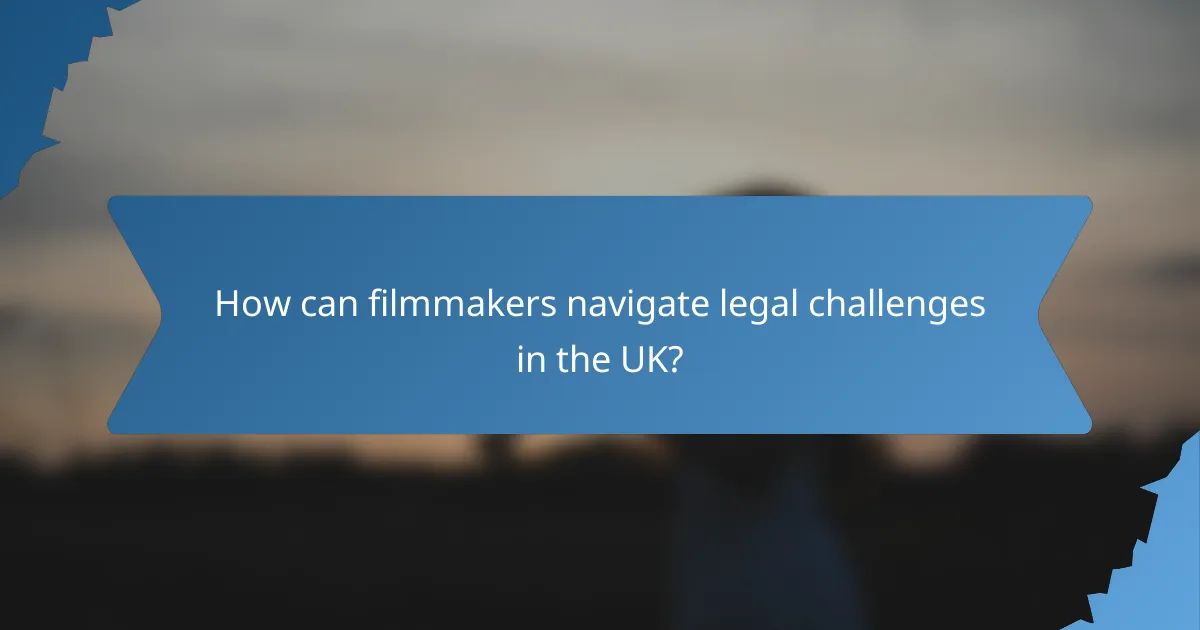
How can filmmakers navigate legal challenges in the UK?
Filmmakers in the UK can effectively navigate legal challenges by understanding relevant laws and seeking expert advice. This approach helps ensure compliance with regulations while protecting freedom of expression in activist documentaries.
Consulting legal experts
Engaging with legal experts is crucial for filmmakers facing potential legal issues. Lawyers specializing in media law can provide tailored advice on copyright, defamation, and privacy concerns, helping to mitigate risks before production begins.
Consider establishing a relationship with a legal advisor early in the project. This proactive step can save time and resources by identifying potential legal pitfalls and suggesting creative solutions to avoid them.
Understanding media law
A solid grasp of media law is essential for filmmakers to navigate the legal landscape effectively. Key areas include copyright law, which protects original works; defamation law, which addresses false statements; and privacy rights, which safeguard individuals’ personal information.
Filmmakers should familiarize themselves with the UK’s specific regulations, such as the Defamation Act and the Data Protection Act. This knowledge enables them to make informed decisions about content and avoid legal disputes that could arise from their work.

What are the historical contexts of censorship in UK documentaries?
Censorship in UK documentaries has evolved through various political and social movements, often reflecting broader societal tensions. Historically, filmmakers have faced restrictions based on content deemed politically sensitive or contrary to public morals.
Notable censorship cases
Several high-profile cases highlight the challenges faced by documentary filmmakers in the UK. For instance, the 1984 documentary “The Battle of Orgreave” was initially suppressed due to its portrayal of police actions during the miners’ strike. Similarly, “The Act of Killing,” which examines the Indonesian genocide, faced significant pushback regarding its graphic content and political implications.
Impact of political climate
The political climate significantly influences censorship in UK documentaries. During times of political unrest, such as the Thatcher era, filmmakers often encountered heightened scrutiny and restrictions. Current debates around freedom of expression continue to shape the landscape, with filmmakers needing to navigate complex regulations and public sentiment.
Documentaries addressing controversial topics, like immigration or government accountability, may face increased challenges in distribution and funding. Understanding the current political environment is crucial for filmmakers to anticipate potential censorship issues and develop strategies to mitigate them.
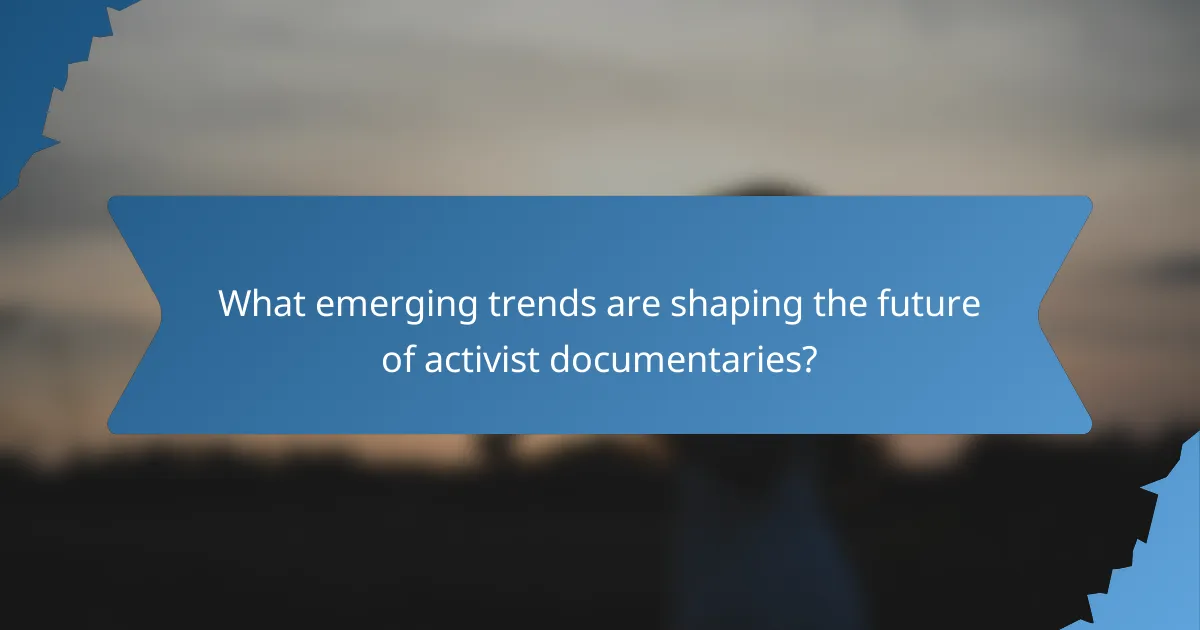
What emerging trends are shaping the future of activist documentaries?
Emerging trends in activist documentaries are increasingly influenced by technological advancements, audience engagement strategies, and evolving legal frameworks. These factors are reshaping how stories are told and distributed, making activism more accessible and impactful.
Legal challenges and protections for filmmakers
Legal challenges for activist filmmakers often revolve around issues like copyright, defamation, and privacy laws. Filmmakers must navigate these regulations to protect their work while ensuring they do not infringe on others’ rights. Understanding local laws is crucial, as regulations can vary significantly between countries.
In some regions, filmmakers may find protections under laws that support freedom of expression, but these can be limited. For example, in the United States, the First Amendment provides strong protections, while in other countries, such as Turkey or Russia, legal frameworks may impose stricter controls on documentary content.
Freedom of expression in documentary filmmaking
Freedom of expression is a fundamental principle that allows filmmakers to explore and present controversial topics. However, this freedom is often challenged by governmental censorship, societal pressures, and funding limitations. Activist filmmakers must balance their message with the potential repercussions of their work.
To navigate these challenges, many filmmakers are employing creative strategies, such as using anonymous interviews or crowd-sourced funding, to maintain their independence and protect their subjects. This approach not only fosters a more open dialogue but also encourages diverse perspectives in storytelling.
Creative solutions to censorship
Creative solutions to censorship in activist documentaries often involve innovative storytelling techniques and alternative distribution methods. Filmmakers are increasingly using animation, reenactments, or abstract visuals to convey sensitive topics without direct representation, thus circumventing potential legal issues.
Additionally, leveraging digital platforms for distribution can help bypass traditional gatekeepers who may impose censorship. Platforms like Vimeo or YouTube allow filmmakers to reach global audiences directly, increasing visibility and support for their causes. However, filmmakers should remain aware of the platform’s policies and potential risks of content removal.
